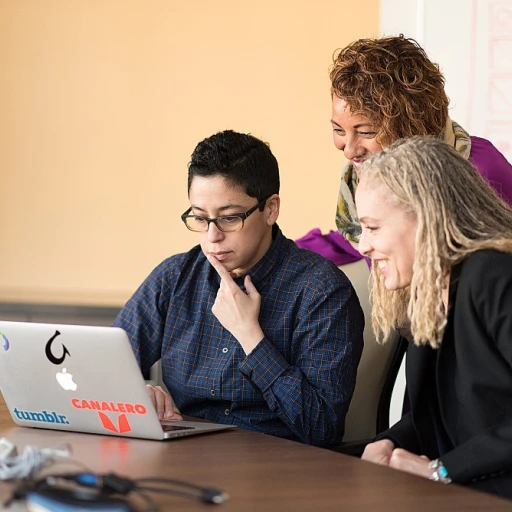
Understanding the Role of Continuous Learning in Leadership
The Impact of Continuous Learning on Leadership
In the ever-evolving landscape of business and management, continuous learning has emerged as a cornerstone of effective leadership. It is not merely about acquiring new knowledge but a commitment to adapt and evolve. Leaders who engage in ongoing development are more adept at navigating the complexities of today's work environment, fostering a culture that encourages team members to thrive. Continuous learning equips people leaders with the skills necessary to adapt their leadership style to achieve optimal results. Through this process, leaders become more people oriented, enhancing their emotional intelligence and ability to connect with their teams. This connection leads to a more effective people management approach where team goals align seamlessly with individual development. One key aspect of continuous learning is its role in promoting thought leadership. Leaders who are knowledgeable and well-versed in their fields can better share innovative ideas, igniting a spark of creativity within their teams. They save time by strategically applying best practices and insights gained from their learning journey, which ultimately contributes to a high-performing team. Additionally, as detailed in understanding the essence, a leader's commitment to lifelong learning sets the tone for a culture of growth. This environment allows team members to feel encouraged and supported as they pursue their personal and professional development goals, leading to a more motivated and engaged workforce. Ultimately, the role of continuous learning in leadership cannot be overstated. It is a vital component of leadership development that ensures leaders remain relevant and effective in a rapidly changing world. By prioritizing their own growth, leaders demonstrate a powerful example for their teams, fostering an environment that values both individual and collective advancement.Adapting to Change: A Leader's Learning Journey
Navigating Change Through the Learning Lens
Adapting to change is a critical attribute for leaders in today's fast-paced business environment. Effective people leaders continuously hone their ability to recognize and respond to shifts in the market, technology, and team dynamics. This skill is crucial not just for personal growth but also for influencing a high-performing work environment and ensuring the team remains aligned with organizational goals.
Leaders who prioritize leadership development through continuous learning often manifest a flexible leadership style. By staying open to new information and perspectives, they save time and resources in implementing changes that could take an organization to the next level. As a result, these thought leaders not only improve their emotional intelligence but also foster a culture of good communication and trust within their teams.
One thought leadership strategy involves viewing each day as an opportunity for learning and development. For instance, reading industry-related books or articles, listening to business reviews and management podcasts, and attending workshops can enhance skills and thought processes. Ultimately, this fuels a leader's ability to share valuable insights with their team members, driving success and growth.
Incorporating continuous learning into one's leadership style requires commitment to that initial learning phase, where leaders understand not just the technical aspects of their roles but also the people-oriented leadership skills that encourage a supportive and innovative work environment. By doing so, they model an approach that encourages their employees to pursue their own learning goals, leading to a more effective and cohesive team.
To dive deeper into understanding this process, you might find the insights offered in ensuring competency in continuous learning particularly illuminating.
Building a Learning Culture Within Teams
Fostering a Culture of Learning and Growth
Creating a learning culture within teams is crucial for leaders striving to enhance their leadership skills and support the development of high-performing teams. A people-oriented leadership style encourages team members to continually develop their abilities, ensuring the team remains adaptable and resilient in the face of inevitable workplace challenges.
Building a learning culture starts with embodying the principles of continuous improvement and emotional intelligence. Leaders can cultivate an environment that values development through the following approaches:
- Encourage Open Communication: By fostering an open dialogue, leaders demonstrate that all ideas, innovations, and suggestions from team members are valued. This openness not only saves time in decision-making but also builds a cohesive and inclusive work environment.
- Share Thought Leadership: Regularly sharing articles from reliable sources, such as the business review by Harvard Business, provides team members with insights into best practices in leadership development.
- Set Clear Learning Goals: Leaders, by coordinating with team members, can design specific, measurable, achievable, relevant, and time-bound (SMART) learning objectives. These goals guide personal and professional development, aligning individual growth with the overall objectives of the business.
- Provide Access to Resources: Thought leaders must ensure that employees have access to a variety of learning materials and platforms. This could include online courses, industry seminars, and mentorship programs that support their ongoing development.
- Recognize and Reward Growth: Acknowledging team members’ progress and achievements reinforces the importance of continuous learning. Recognition programs motivate employees to persist in their development efforts.
Creating a people leadership culture that prioritizes growth and learning ultimately leads to more effective people management. This approach not just enriches leadership styles but also sets a foundation for sustainable business growth by cultivating a motivated, innovative, and adaptable workforce.
Tools and Resources for Lifelong Learning
Empowering Leaders with Digital Learning Platforms
In today's fast-paced business environment, leveraging digital learning platforms can significantly enhance the learning journey of a leader. These tools allow leaders to manage their time effectively while accessing a vast array of resources tailored to their growth needs. For leaders striving to develop their leadership style and refine their leadership skills, online courses, webinars, and podcasts serve as accessible options. These resources cater to various learning preferences, ensuring that leaders can choose the best format that aligns with their learning objectives and fits into their work schedule.Enhancing Emotional Intelligence with Developmental Feedback
Continuous learning also involves receiving and integrating developmental feedback. Emotional intelligence is crucial for a people-oriented leadership approach. Leveraging feedback mechanisms allows leaders to foster self-awareness and adapt their leadership style. Leaders should be open to feedback from team members and peers, encouraging a culture of open communication and collaborative development. By sharing feedback, leaders can pinpoint areas for improvement and enhance their decision-making and interpersonal skills, which ultimately benefits the entire team.Harnessing the Power of Thought Leadership Content
Access to well-curated content from thought leaders across industries is another valuable tool for continuous learning. Leaders can save time by subscribing to thought leadership articles, industry reports, and online magazines such as Harvard Business Review, which offer the latest insights and strategies in leadership development and management practices. By engaging with this content, leaders stay informed on emerging trends and best practices, aiding them in making informed decisions and maintaining a high-performing work environment.Utilizing Collaborative Learning Tools
Collaboration-focused tools can also be instrumental for leaders aiming to build a strong learning culture within their teams. Platforms that support collaborative learning allow team members to share knowledge, insights, and skills effectively. Adopting these tools enables leaders to create an environment where team members learn from each other and contribute to collective goals. By fostering collaborative learning, leaders ensure ongoing development and establish a resilient and adaptable team ready to tackle future challenges. Leaders committed to continuous development understand the significance of equipping themselves with the right resources and tools to facilitate their lifelong learning journey. These tools empower them to lead with confidence, inspire their teams, and drive business success.Overcoming Barriers to Continuous Learning
Breaking Down Barriers to Lifelong Learning
As leaders embark on their continuous learning journey, they often encounter various barriers that can hinder progress. Understanding and overcoming these challenges is essential to cultivating an environment where continuous learning thrives, both individually and within teams. Here are some common obstacles and effective strategies to overcome them:
- Time Constraints: Managing time effectively while juggling multiple responsibilities can be daunting for leaders. Allocating dedicated time to learning amidst continuous work pressure is crucial. Consider integrating learning goals into existing routines or setting aside short breaks for reading and reflection. Prioritizing learning as an essential task and scheduling it just like any other business activity can optimize your time management.
- Lack of Resources: Access to quality resources is vital for effective learning and development. Leaders should explore platforms that offer comprehensive and credible materials, allowing them to stay updated with the latest in thought leadership and management practices. Investing in memberships to reputable business review sites or subscribing to leadership development journals are some viable solutions that can enhance the learning experience.
- Fear of Change: Embracing change is a hallmark of good leadership, yet many people resist it due to fear of the unknown. Developing emotional intelligence and fostering a growth mindset can empower leaders to embrace change positively. Sharing experiences with team members can cultivate a people-oriented leadership style that encourages collective learning and growth.
- Inadequate Support: Without support from peers and higher management, sustaining a culture of continuous learning can be challenging. Leaders should advocate for learning opportunities within their teams and actively engage in discussions regarding personal development and success. Building a supportive network where team members freely share knowledge and skills contributes to a high-performing work environment.
By addressing these barriers, leaders not only enhance their learning journey but also instill a culture of continuous development within their teams. Thus, fostering an environment where everyone is empowered to learn, grow, and contribute to shared goals.
Real-Life Examples of Leaders Who Embrace Continuous Learning
Real-World Leaders Who Embody Continuous Learning
In the dynamic world of business, effective leaders are those who continuously evolve. They understand that leadership development is not a one-time event but a lifelong journey. By embracing continuous learning, these leaders not only enhance their own skills but also inspire their teams to do the same.
Embracing Change and Innovation
Consider leaders who have successfully navigated their organizations through periods of significant change. These individuals often exhibit a strong commitment to learning, adapting their leadership style to meet new challenges. They prioritize understanding the latest trends and technologies, ensuring their teams remain high performing in a competitive environment.
Fostering a Learning Culture
Leaders who prioritize a learning culture within their teams often see the best results. By encouraging team members to share knowledge and skills, they create a work environment that values growth and development. This approach not only saves time in problem-solving but also enhances the emotional intelligence of the team, leading to more effective people leadership.
Overcoming Barriers to Learning
Real-life examples of leaders who have overcome barriers to continuous learning often involve a commitment to personal and professional growth. These leaders recognize the importance of setting clear goals and actively seek out resources and thought leadership to guide their journey. By doing so, they demonstrate to their employees the value of lifelong learning.
Thought Leaders in Action
Thought leaders in various industries exemplify the power of continuous learning. They are often featured in business reviews and are known for their ability to adapt and innovate. Their success is a testament to the importance of staying informed and being open to new ideas, ultimately leading to better management and leadership skills.












